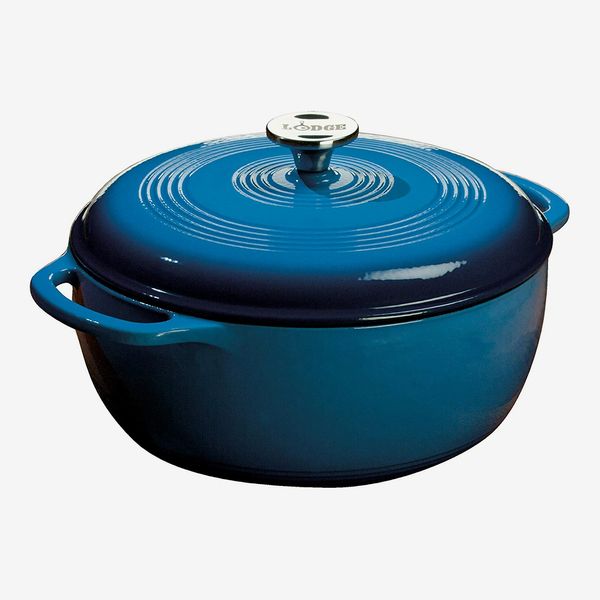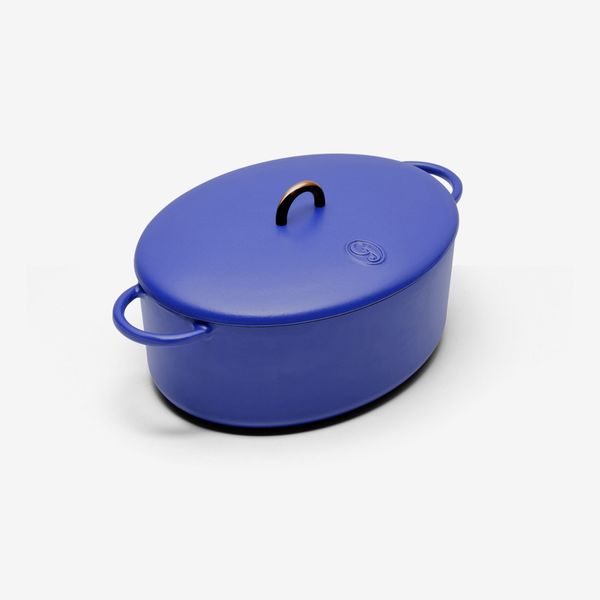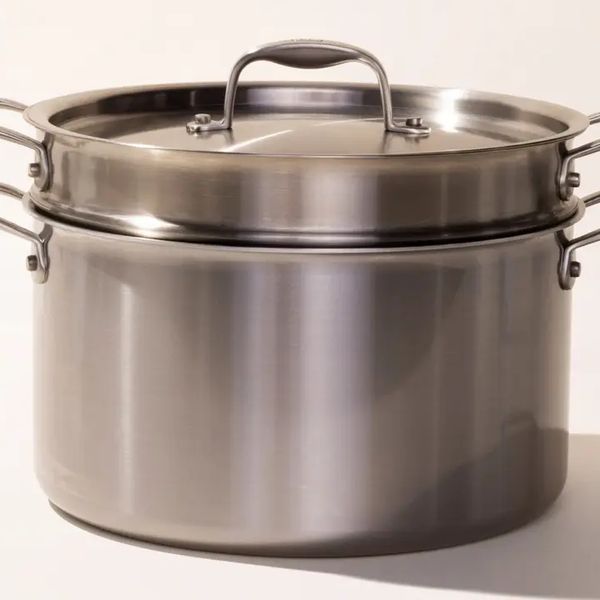
In this article
My Dutch oven sits proudly on my stovetop at all times. Otherwise, there’s a rotating cast of characters (sometimes the nonstick I use for my morning eggs, sometimes a sauté pan drying on a back burner). But the large enameled pot stays. It’s a kitchen staple in line with sheet pans and high-quality knives — the kind of tool everyone, if they cook at all, should own. Dutch ovens are heavy-bottomed and thick-sided, which lets them hold very even heat. They’re also wide enough to sear meats and brown vegetables, but tall enough to contain a substantial amount of liquid, ideal for soups and stews. They go from stove to oven, the champions of braises. You can use them to fry, make rice dishes, bake bread, build pasta sauces and curries, roast whole chickens, and more.
Still, Dutch ovens have a reputation for being pricey and therefore a bit unapproachable. This is namely because the two most well-known brands, Le Creuset and Staub (which I own and love deeply), will run you upwards of a few hundred dollars. While I think if you can swing it, they’re worth the investment (just like a top-tier blender), I talked to a dozen professional cooks who recommend multiple more affordable pieces in addition to those all stars. So while you might be able to use one of the more expensive models for your entire life and even pass it down, as long as you buy a decent version, you should get years of quality use. And if you’re building out your whole cookware collection, you can find my guide to the best cookware sets, too.
Update on December 13, 2024: Updated prices and checked stock for all products.
What we’re looking for
Material
With the exception of one raw cast-iron Dutch oven and one enameled carbon steel, all others on this list are made from enameled cast iron. Enameled coatings make the surface smooth and fairly nonstick without having to season. The downside is that the layer can be subject to scratching or chipping, and once that happens, it can’t be reseasoned. But, really, damage is rare if you take good care of your pot, ideally hand-washing it (even though some say they’re dishwasher safe) and avoiding abrasive metal utensils. Meanwhile, carbon steel is a very similar material to cast iron, also with solid heat conductivity but much lighter weight.
Size
There are a couple of Dutch ovens on this list that only come in one size: Great Jones’ 6.75-quart and Lodge’s 3.2-quart. Two, the Dansk casserole-style Dutch oven and Made In’s, come in two sizes. The others are all offered in a fairly large range (from as small as half-a-quart to as large as 13-and-a-quarter). To keep things as streamlined as possible for those with more than two options, I listed the range of sizes but linked to and included only the price for the model with the closest number of quarts to 5.5, a standard for feeding approximately four people.
Weight
Here, I’ve given the weight that corresponds with the linked-to size of each Dutch oven. While all Dutch ovens tend to be fairly heavy and, no matter what, require two hands to maneuver around the kitchen and clean, take note of the small weight differences, if that’s important to you.
Best Dutch oven overall
Material: Enameled cast iron | Size: .5–13.25 quarts | Weight: 12 pounds, 8 ounces
This is the Dutch oven I’ve owned for seven years, and the one that was recommended by far and away the most experts. It works just as well as the day I got it and has proven to be durable on the inside and out. It distributes heat incredibly evenly, whether I’m searing meat at a high temperature, sweating out onions low and slow, or leaving a braise in the oven for several hours. And it’s responsive to variations in heat, too (more so than a heavy cast-iron skillet): I can start something blazing hot, then take it down, then bring it back up seamlessly.
And though it’s easy to argue that both this and the Le Creuset are quite similar in terms of price point, durability, and overall superior build (I’m convinced that people’s preference for one or the other at least partially comes from which model they happened to get their hands on first), Staub has a couple of standout features.
One is the black, instead of white, interior. While discoloration isn’t a sign that your Dutch oven has stopped working, I like that mine has stayed clean-looking on the inside. (And it’s not just that the dark color is hiding grime; the surface washes up well.) “I had a Le Creuset for a long time and it eventually got a little brown and scratched,” says Colin Wyatt, executive chef at Twelve in Portland, Maine. “Staub looks great with age.” Both recipe developer and food writer Grace Elkus and recipe developer Tara O’Brady say the darker color is helpful for bread baking, too. “The crust gets that chestnut-brown shade, which lighter interiors aren’t able to achieve,” O’Brady says.
She also points out the comfortable grip. “No matter what I’m handing it with — dish towels, a silicone mitt, a regular mitt — it has good sturdy, wide, thick handles that hold well,” she says. I personally lift mine with ease, move it around the stove, and take it in and out of the oven; it’s sturdy but not cumbersome. The lid fits tight and secure, and in addition has concentric dimples on the bottom, a characteristic that is meant to promote even condensation and drippage as steam builds inside of your pot. Both Wyatt and Meherewan Irani, owner of Chai Pani in Asheville, North Carolina, and founder of Spicewalla, say this actually makes a difference. “When it’s in the oven for a long time, the Staub seems to keep meat particularly tender and prevents it from drying out in any spot,” Irani says.
Though the Dutch oven comes in many gorgeous shades, O’Brady and Jay Wolman, owner of New York City’s Mimi, say they like the all-black one because the outside doesn’t show as much wear either. While that won’t affect performance, if you care about a super-clean look over time, it’s something to keep in mind. (My light-gray version has some markings on the very bottom of the outside.)
Best classic Dutch oven
Material: Enameled cast iron | Size: 2–13.25 quarts | Weight: 11 pounds, 4 ounces
In the 1920s, Le Creuset invented the Dutch oven as we know it today, forging a Dutch metal-casting method with the smooth enamel coating. The design took off quickly and has never fallen out of favor (it’s the most ubiquitous brand seen in the kitchens of celebrities and celebrity chefs alike, including Marilyn Monroe, Julia Child, Nigella Lawson, Taylor Swift, and too many more to count). Though I don’t own one myself, I’ve used Le Creusets many times (including in my parents’ kitchen, where I grew up cooking) and can attest that the build and heat conduction is equal to that of my beloved Staub.
Recipe developer and cookbook author Alexis deBoschnek has had hers for a decade, and Alexandra Wight, owner of Crown Jewel in Great Diamond Island, Maine, for nearly double that. Despite what some others warned about discoloration, deBoschneck says that has happened only minorly, and Wight says not at all with hers, adding, “It’s super-easy to clean. I love that you can throw it in the dishwasher. I don’t always do that, but I like to know that the option is there, especially as a mother of three children who make a lot of dishes.”
As for performance, Le Creuset “cooks really evenly across the board, whether on the stove, in the oven, or even in a smoker,” deBoschnek says. “The lid is tight fitting. The nonstick quality has lasted. It feels easy to handle.” Former Strategist editor Maxine Builder tested a bunch of cheaper Dutch ovens against her Le Creuset to see how they would measure up. In the end, while she found some decent alternatives, in time she gave most of the others away in favor of this classic (save for the last casserole-style one on this list, the only other one she kept).
Best less expensive Dutch oven
Material: Enameled cast iron | Size: 5.5 quarts | Weight: 13 pounds, 11 ounces
Made In, a relative newcomer on the cookware scene, produces some of our favorite knives, skillets, and baking dishes. Now, we can add their Dutch oven to that list. I’ve been using mine for several months and so far, it seems just as well made as my Staub. Indeed, it’s crafted in France, piggybacking on the century-old craftsmanship of Le Creuset (and later, Staub) — “but is a fraction of the price,” says Jorge Gaviria, founder of Masienda, who has been using his for over a year. “The brand works with legacy producers to fabricate all of the quality of those heritage companies but for less money.”
In my experience, it conducts consistently even heat, both on the stovetop and in the oven, through multiple steps of a cooking process (like when I sear chicken thighs to golden-brown, then sweat out alliums, then put everything back in the pot along with rice and water to cook together, or when I sear meatballs and then let them simmer with sauce on low for a long time, pictured below). Gaviria even says it works on what he calls the “really crappy coil burners” he has at home. It feels solidly built, has a tight-fitting lid (with a bigger knob than the Staub to open and close), and secure handles that make it comfortable to maneuver.
Best even less expensive Dutch oven
Material: Enameled cast iron | Size: 1.5–7.5 quarts | Weight: 13 pounds, 8 ounces
Both Todd Pulsinelli, executive chef at Sylvain in New Orleans, and Irani swear by Lodge’s enameled cast-iron Dutch oven, which comes in at a striking $110 less than Made In’s. Lodge is most well-known for their standard cast-iron skillets, in part due to how well-made they are for the price. That reputation holds for this product, too. Both pros have had theirs for about eight years, use it all the time, and say it’s in just as good of shape as it was when they bought it, with Irani calling it “pretty damn near indestructible.” While he acknowledges that the Staub is a bit more refined-looking than the Lodge, he still appreciates that the latter comes in multiple colors and says its plenty attractive to keep out on his stove.
Best oval Dutch oven
Material: Enameled cast iron | Size: 6.75 quarts | Weight: 15 pounds
This is the largest Dutch oven on this list and, notably, the only one in an oval. While that means it takes up a bit more room on your stovetop, the size and shape also give it certain advantages. “It’s perfect for roasting or poaching a whole chicken,” says chef Camille Becerra (in a round pot of similar size, a bird would be a tight fit). She adds that it’s particularly conducive for larger-batch liquid-based foods that ask you to cram quite a few ingredients into one pot, like soup and stock, as well as dishes that require a large surface area for browning meats, like arroz con pollo. She insists the shape doesn’t have a negative impact on heat distribution. “It still spreads very evenly,” she says. The price is also quite reasonable, coming in at slightly less than Made In’s (though more than the Lodge).
Best lightweight Dutch oven
Material: Enameled carbon steel | Size: 2 quarts and 4 quarts | Weight: 5 pounds, 7 ounces
This Dansk Købenstyle is the only other Dutch oven (besides her original Le Creuset) that former Strategist editor Maxine Builder kept from her 2019 tests — and she still stands by what she wrote then. (I own the similarly built, long-handled saucepan version of this, and love it.)
The main difference between this Dutch oven (or casserole dish, as the brand calls it) and the others on this list is that it’s made from lightweight carbon steel instead of cast-iron. This means it’s “easy to carry around a kitchen, even when it’s hot,” Builder says. Even still, as with carbon steel skillets, it “retains heat well,” she says. Because the 4-quart option is on the smaller side, she doesn’t use it for large braises or pot roasts, but still likes the size for cooking for one or two. “And it’s easy to store and not as much of a thing to take out of my cabinet,” she says. Then there’s the fact that the Dansk simply looks cool, with its “unique mid-century design,” as Builder puts it. The spiderlike handles don’t look like they should work, she says, but in fact feel sturdy, and even after all these years of cooking tomato-based sauces and curries, the inside hasn’t stained.
Best Dutch oven for bread
Material: Cast iron | Size: 3.2 quarts | Weight: 12 pounds, 14 ounces
This offering from Lodge isn’t enameled; instead, it’s made from the same raw cast-iron material as the brand’s skillets. As with Staub’s, the darker interior color is great for achieving an ideal crust color on bread. That’s the primary thing Georgia Macon, executive pastry chef at Twelve, makes in it. Instead of a traditional deep pot with a thinner lid, she explains, it’s a slightly shallower pot with a skillet as a lid — not only a two-in-one deal but a build that allows for easy maneuvering when baking a loaf. “Every other option on the market leaves you ripe with chances to burn your forearms,” Macon says. “With this, you load into the lid and then put the bottom on top to cover it. Loading and unloading is miles easier.” Macon uses the set for other dishes, too, like braises, searing meats, and making popcorn. When doing that, however, she cautions that you have to season the metal before to ensure foods don’t stick. (With bread, the high-cook heat and dusting of flour doesn’t render seasoning necessary.)
Some more cookware we’ve written about
Our experts
• Camille Becerra, chef
• Maxine Builder, former Strategist editor
• Alexis deBoschnek, recipe developer and cookbook author
• Grace Elkus, recipe developer and food writer
• Jorge Gaviria, founder of Masienda
• Meherewan Irani, owner of Chai Pani
• Georgia Macon, executive pastry chef at Twelve
• Tara O’Brady, recipe developer
• Todd Pulsinelli, executive chef at Sylvain
• Alexandra Wight, owner of Crown Jewel
• Jay Wolman, owner of Mimi
• Colin Wyatt, executive chef at Twelve
The Strategist is designed to surface the most useful, expert recommendations for things to buy across the vast e-commerce landscape. Some of our latest conquests include the best acne treatments, rolling luggage, pillows for side sleepers, natural anxiety remedies, and bath towels. We update links when possible, but note that deals can expire and all prices are subject to change.
Every editorial product is independently selected. If you buy something through our links, New York may earn an affiliate commission.


















